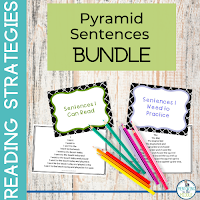It was the beginning of the year and I was evaluating my students for oral reading fluency.
Her reading was choppy and slow; she read as softly as she could so others wouldn't hear.
She knew she struggled with reading, and I knew I needed to help her. She'd somehow fallen through the cracks because she'd moved into our district halfway through last year.
Faking her way through reading had gotten her only so far, though, and I suspected she knew she was at the end of the line. I told her we'd work on smoothing out and speeding up her reading. She looked up nervously; she wanted the help, but she didn't want anyone else to know.
Does that sound familiar? That's pretty typical in 6th grade when students are starting to measure themselves against their peers.
Here are some tips and strategies I used that were helpful.
1. Start working on words and phrases right away
I created reading fluency pyramids for her and several other students because they use repetition. Fluency pyramids are sentences that are read one word at a time, with a repetition of what's already been read. So, for example, if the sentence was "The boy ran down the street, " the student would read The. The boy. The boy ran. And so on.
A small group of students worked on them. I was surprised that they thought these were fun. Kids who were comfortable working with a partner did so, others worked alone.
Every so often, they would read them out loud and I would time them. Their faces lit up as their times improved! A small, but significant win!
2. Pick out vocabulary words that are challenging
This one can go several ways. A student might not know how to pronounce the word but they know the meaning once they realize what the word is. Sometimes they can pronounce the word, but they have no idea what it means. Or they might not know the pronunciation or the meaning.
She wanted to read A Wrinkle in Time. Although it's considered a good book for this age, I was worried it would be too difficult. But she'd seen the movie and thought that that might help her. I'm a big fan of student choice in books, so off she went.
I had her skim the pages first, and pick out words that looked unfamiliar. Just in the second paragraph alone, we found 3 words she didn't know.
In her attic bedroom Margaret Murry, wrapped in an old patchwork quilt, sat on the foot of her bed and watched the trees tossing in the frenzied lashing of the wind. Behind the trees clouds scudded frantically across the sky. Every few moments the moon ripped through them, creating wraithlike shadows that raced along the ground.
This was going to be a problem, but I could see she wasn't ready to give up yet. I wasn't ready to encourage a different choice yet. I try to be real with kids, but I've seen a few keep working away at it. She was so eager to keep going that I let her.
Her job: preview the pages and write unfamiliar words into her journal, look them up and jot down definitions.
My job: Meet with her every day or two to check in and see how she was doing. Was she still writing down a lot of words?
3. Confer with these students
Kids who struggle to read required a lot of time in the beginning, and I was determined to find it. That's not easy! In the days when I had 1 1/2 hours for ELA, I met with students individually every day. But now that my class time was down to an hour, it was much harder.
Still, I wanted to see her improve, so we checked in regularly during silent reading time.
4. Find an audio version of the book
Although you want students to improve on their own, you also don't want to take the joy out of reading. I was concerned that the work she had to do just to understand a single page was going to be too much.
It turned out that way.
Note: I have no problem with students who use audiobooks, but if fluency is a challenge, it's important to have them read along with the text. Listening alone is wonderful, and appropriate for some students, but kids who need to work on fluency need to have time to practice that skill.
5. Graphic novels are a great tool
Graphic novels provide picture clues and make reading so much less painful for kids like this young girl.
She started The Amulet series and loved it. The smile on her face when she was reading was totally worth it. From there, she alternated between Diary of a Wimpy Kid and The Dork Diaries books.
Pick out vocab words that aren't recognized or kids don't know how to pronounce - kids work on that first (don't overdo!)
She was one determined young lady! She picked up the book again in March or April, and we were both thrilled when she was able to finish it, using the audiobook and following along with her own copy. She even recorded herself reading a paragraph, then later, two, and finally, a full page. She had come a long way!
- This bundle would be perfect for your students who struggle with fluency.





No comments
Post a Comment